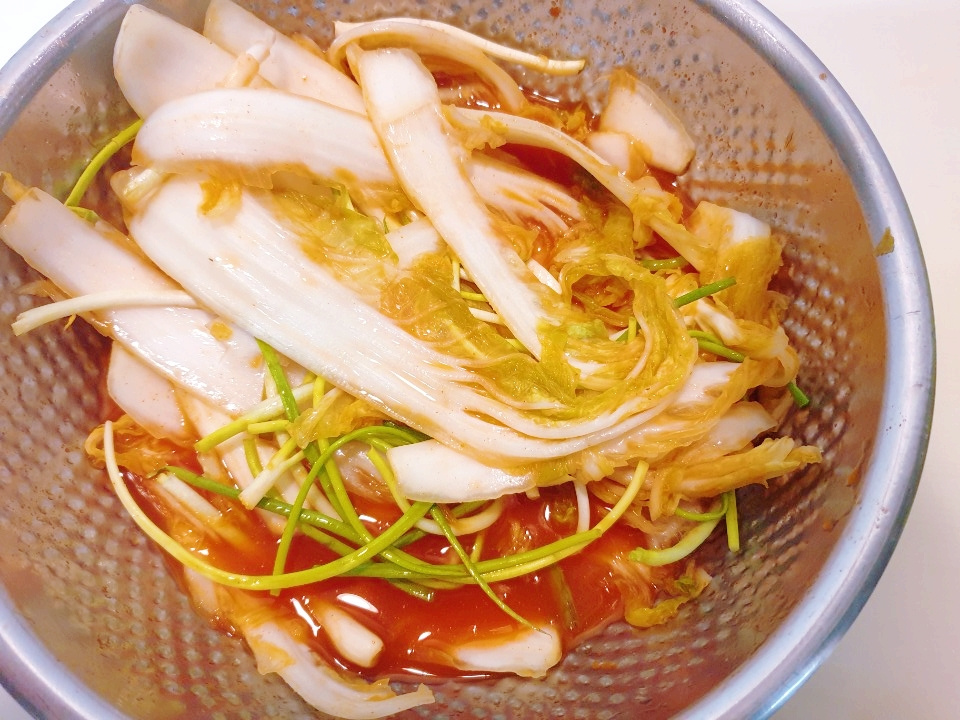Refreshing and Clear Mul-Kimchi (Water Kimchi)
How to Make Delicious Mul-Kimchi at Home

I made this mul-kimchi because I often enjoyed it at Korean BBQ restaurants. This recipe brings that refreshing taste to your table!
Main Ingredients- 1/2 head of Napa Cabbage (choose fresh and crisp ones)
- 3 Tbsp Coarse Sea Salt (for salting the cabbage)
- 3 stalks of Scallions (wash and cut into 2-3 cm lengths)
Mul-Kimchi Broth & Seasoning Ingredients (using small teaspoon as reference)- 2 Red Chilies (seeds removed, finely chopped or blended)
- 1 tsp Grated Ginger
- 1 Tbsp Fermented Shrimp (minced finely. Using the brine too adds more umami)
- 1 Tbsp Cider (adds sweetness and a refreshing fizz)
- 2 Tbsp Plum Extract (for a sweet and sour taste)
- 1 Tbsp Cooked Sweet Rice Paste (glutinous rice paste)
- 100ml Water (for the broth base)
- 5cm piece of Radish (thinly sliced or julienned)
- 1/4 Pear or Apple (seeds removed, blend in a mixer. Adds sweetness and flavor)
- 2 Red Chilies (seeds removed, finely chopped or blended)
- 1 tsp Grated Ginger
- 1 Tbsp Fermented Shrimp (minced finely. Using the brine too adds more umami)
- 1 Tbsp Cider (adds sweetness and a refreshing fizz)
- 2 Tbsp Plum Extract (for a sweet and sour taste)
- 1 Tbsp Cooked Sweet Rice Paste (glutinous rice paste)
- 100ml Water (for the broth base)
- 5cm piece of Radish (thinly sliced or julienned)
- 1/4 Pear or Apple (seeds removed, blend in a mixer. Adds sweetness and flavor)
Cooking Instructions
Step 1
First, wash the Napa cabbage thoroughly. Remove the base and cut it into bite-sized pieces (about 4-5 cm). Avoid cutting them too small, as they might become mushy.

Step 2
Sprinkle 2 Tbsp of coarse sea salt evenly over the cut cabbage. Make sure the salt penetrates the stem parts well.

Step 3
Let the cabbage wilt and soften for about 5 hours, or until it feels pliable. Stirring it once in between helps it salt evenly. After salting, rinse the cabbage 2-3 times under cold water to remove excess salt. Drain thoroughly in a colander.

Step 4
Spread the drained cabbage on a sieve or rack to allow any remaining water to drip off naturally. Don’t squeeze it too hard.

Step 5
In a separate bowl, dissolve 1 Tbsp of salt in 100ml of water. Add the drained cabbage and gently toss to coat. This step helps the cabbage stay crisp.

Step 6
Prepare the sweet rice paste beforehand. You can make it by mixing 1 tsp of glutinous rice flour with about 2 small soju cups of water and simmering on low heat until thickened. (Alternatively, you can use store-bought sweet rice paste.)

Step 7
Now, let’s make the mul-kimchi seasoning paste. In a blender, combine 2 red chilies (seeds removed, finely chopped or blended), 1 tsp grated ginger, 1 Tbsp finely minced fermented shrimp (including the brine), 1 Tbsp cider, 2 Tbsp plum extract, 1 Tbsp cooked sweet rice paste, 100ml water, a piece of radish about two finger-joints long (approx. 5cm), and 1/4 pear or apple (seeds removed). Blend until smooth. The fruit adds sweetness and a rich aroma.

Step 8
In a bowl, place 2 Tbsp of gochugaru and pour in 200ml of water. Stir well to dissolve any clumps. Let it sit for about 10 minutes to allow the chili flakes to fully hydrate and release their color.

Step 9
Strain the blended seasoning paste and the hydrated gochugaru mixture through a fine-mesh sieve or cheesecloth to obtain only the clear liquid. Removing the solids results in a clearer mul-kimchi.

Step 10
Pour both the strained seasoning liquid and the gochugaru liquid into a large bowl and mix them well. Stir until all the seasonings are evenly incorporated.

Step 11
Now, add the prepared cabbage to the broth. Gently mix to ensure the cabbage is submerged in the liquid.

Step 12
Finally, add the washed and cut scallions and mix lightly. The scallions add a beautiful color and a fragrant aroma to the kimchi.

Step 13
Transfer the finished mul-kimchi into an airtight container. It’s important that the kimchi is submerged in the liquid for optimal flavor development.

Step 14
Let the mul-kimchi sit at room temperature for about half a day (2-3 hours in summer, 6-8 hours in winter), then refrigerate. It will taste best when served chilled. As it ferments, it will develop a pleasant sourness.




